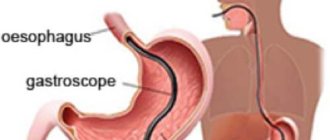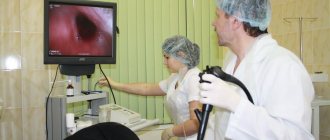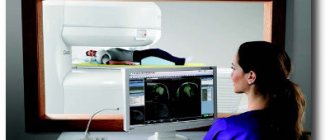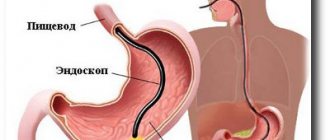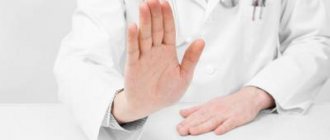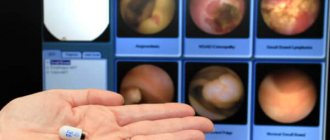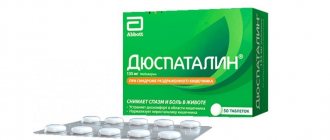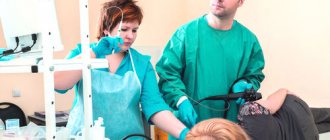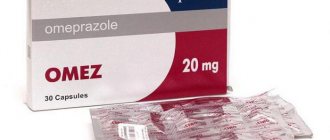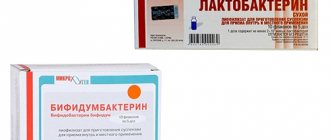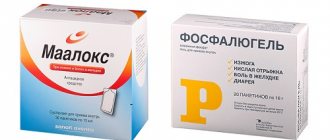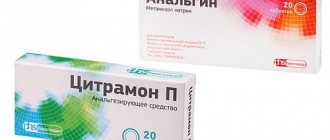Decoding concepts
EGDS (gastroscopy, esophagogastroduodenoscopy) is a study of the upper parts of the digestive tract (esophagus, stomach, duodenum) using a special device called an endoscope. It allows you to examine this part of the digestive system from the inside and make a diagnosis with maximum accuracy. Moreover, modern endoscopy is not limited only to examination ; if necessary, it is accompanied by a biopsy (tissue sampling for morphological examination) and a urease test (detection of H. pylory).
If the complex name of this diagnostic procedure “esophagogastroduodenoscopy” is broken down into its component parts and translated from Greek and Latin, then it will not look so scary: oesophagus (esophagus) - esophagus, gaster - stomach, duodenum - duodenum, skopeo - look.
The essence of the research method
, endoscopes with different technical characteristics and resolution were used for endoscopy
- hard;
- semi-rigid;
- flexible;
- fibrogastroscopes;
- video endoscopes;
- Ultrasonic endoscopes.
Recently, only the last 3 have been used in medicine.
A fibrogastroscope is a flexible endoscope equipped with fiber optics. Translated from Latin: fibra is fiber, gastro is stomach, skopeo is to look. It is this device that is used for FGDS (FEGDS, fibroesophagogastroduodenoscopy).
FGDS is a gastroscopy method that provides the opportunity to examine the same upper parts of the gastrointestinal tract using a fibrogastroscope.
What is the difference?
Are there any differences between EGDS and FGDS? Despite the fact that these concepts imply performing the same procedure, there are still differences.
- Endoscopy is a broader concept; its essence is to conduct an endoscopic examination of the esophagus, stomach, duodenum, using any endoscopes (with direct, lateral, oblique optics, video and ultrasound endoscopes).
- FGDS performs the same function, but with the help of a fibrogastroscope, which is reflected in the name of the procedure.
Fibrogastroscope
Indications, contraindications, preparation for these two studies do not differ significantly.
Indications and contraindications for FGS and FGDS
In terms of technology, there are apparently no differences between FGS and FGDS. The only difference is the time and scope of the examination. But their indications differ. In some cases, simply studying the gastric mucosa is enough, and in some situations a duodenic study is added to it. Let's look at situations where one or another procedure is necessary.
There are general indications for endoscopy:
- pain in the abdomen, localized in the upper part, as well as in the lower chest;
- discomfort in the epigastric region;
- bloating;
- nausea or vomiting;
- heartburn;
- belching and sour taste in the mouth;
- difficulty swallowing;
- sudden changes in weight for no apparent reason, sudden loss or gain of body weight;
- suspicion of gastritis or stomach ulcer;
- suspicion of malignant neoplasms;
- internal bleeding;
- analysis for the presence of the bacterium Heliobacter.
FGDS is performed if there are additional indications:
- suspicions of bile duct disease, including malignant neoplasms;
- suspicion of duodenal ulcer;
- bleeding in the upper parts of the small intestine.
FGDS is also done in combination with x-ray examination of the bile ducts and pancreas. Using an endoscope, a dye is injected, after which an x-ray is taken. This procedure is called retrograde cholangiography.
Despite the differences in indications for gastroscopy and FGDS, they have common contraindications:
- diseases of the cardiovascular system, including changes in blood pressure, hypertension;
- diseases of the respiratory system, including bronchial asthma in the acute stage;
- bleeding disorders and hemophilia;
- severe weakness and painful fatigue;
- nervous disorders and mental illnesses, neuroses;
- severe internal bleeding.
The examination should be prescribed by the attending physician, having first ensured that there are no contraindications. He will also give recommendations on preparation for the procedure and nutrition.
https://www.youtube.com/watch?v=UGqFKX4i4GE
Indications
Gastroscopy (EGDS, FGDS) is one of the main diagnostic methods in gastroenterology. It is available to most medical institutions and acts as an initial instrumental examination in identifying any complaints in a person that may be associated with dysfunction of the upper gastrointestinal tract (with the exception of swallowing disorders). Let us dwell on the main indications for its implementation.
- Suspicion of pathology of the esophagus, stomach, duodenum and surrounding structures : bloody vomiting or the presence of black tarry stool (to determine the source of bleeding); acute or chronic pain in the upper abdomen; dyspepsia, especially in people over 45 years of age (nausea, belching, heartburn, bloating, feeling of fullness after eating); anemia of unknown origin; clarification of the localization of foreign bodies.
- Evaluation of the effectiveness of treatment for diseases of these organs.
- The need to distinguish benign and malignant processes (tumors, foci of dysplasia) from each other and determine its prevalence.
Help Gastroscopy can be used not only for diagnosing diseases, but also for the purpose of carrying out therapeutic procedures (removal of foreign bodies, stopping bleeding, biopsy, removal of polyps, etc.).
In what cases are examinations carried out?
Endoscopy is the most accurate method for diagnosing any diseases of the gastrointestinal tract, which allows you to clearly demonstrate the pathological changes occurring in it. This procedure is prescribed to accurately determine not only the nature of the disease that has arisen, but also its location.
Procedures are prescribed when the following manifestations occur:
- the occurrence of pain in the abdominal area;
- the appearance of a sour taste in the mouth or heartburn;
- feeling of discomfort in the gastrointestinal tract;
- frequent uncontrollable belching;
- difficulty swallowing;
- the need to test for the presence of Helicobacter bacteria;
- sudden weight gain or loss;
- suspicions of the development of gastritis or peptic ulcer of both the stomach and duodenum;
- the presence of open bleeding in the stomach;
- checking for the presence of neoplasms;
- suspicion of a pathological change in the pancreas, gall bladder or liver.
These procedures are performed as a control measure during treatment or recovery, as well as during the annual medical examination of chronic patients.
Contraindications
Despite the information content and relative safety of the procedure, it is not permitted for all patients. In some cases, it can harm the patient's health. There are absolute and relative contraindications to gastroscopy.
Absolute contraindications:
- diseases of the esophagus in which it is impossible to pass an endoscope through it;
- acute ischemia of the heart muscle;
- strokes;
- shock of any origin;
- acute infections;
- severe insufficiency of respiratory and circulatory function;
- pathology of the thyroid gland, which interferes with the procedure;
- suspected organ perforation.
Relative contraindications:
- pregnancy;
- mental disorders;
- acute inflammatory processes in the upper respiratory tract;
- glaucoma.
If a person has conditions that act as relative contraindications to the study, it can be carried out, but only in extreme cases, if it cannot be avoided (if bleeding continues, when it cannot be stopped by other means).
Indications for gastroscopy
Gastroscopy is one of the informative ways to diagnose pathologies of the digestive organs. If there is a need to confirm or refute the diagnosis of gastrointestinal diseases, an endoscopic procedure is prescribed. Indications for endoscopy:
- Feeling of discomfort in the stomach after eating;
- Frequent heartburn;
- Causeless nausea;
- The digestive tract is disrupted;
- Vomiting, unpleasant taste in the mouth;
- Sudden weight loss;
- The patient complains of acute abdominal pain;
- In case of swallowing dysfunction (dysphagia), esophagoscopy is recommended;
- To detect the presence of Helicobacter bacteria;
- Accurate diagnosis of gastritis;
- Suspicions of ulcers, inflammatory processes;
- Examination of the gastrointestinal tract for tumors and neoplasms;
- For internal bleeding of the stomach;
- For pancreatitis (inflammation of the pancreas), hepatitis (liver disease).
Endoscopy is useful for the prevention of diseases of the abdominal organs and timely detection of pathologies at the initial stage. The method used is esophagoscopy (the upper parts of the gastrointestinal tract are studied).
Preparing for the examination
Before a medical examination, consultation with a doctor is required. To ensure the reliability of the results, the patient prepares for the examination. Preparatory activities (for FGDS, EGDS, FGS):
- Ask a gastroenterologist about the rules and process of endoscopy, contraindications, what the consequences are, and whether there is a replacement method for diagnosis.
- Collect the necessary tests; it is recommended to undergo a blood clotting test.
- If there is one, take an ultrasound report of the abdominal cavity, MRI, or x-ray.
- Before the procedure, you need to inform your doctor about any allergies to medications and what medications you are currently taking.
- Two to three days before the examination, a diet plan is prescribed. The consumption of alcohol and medicinal tinctures containing alcohol is prohibited, and smoking should be stopped.
- Endoscopy is performed on an empty stomach. It is better not to drink liquid on the day of the examination.
- To eliminate pain when inserting a probe, use Lidocaine. This helps reduce gagging and discomfort during the procedure.
The patient must strictly follow the recommendations and prescriptions of the gastroenterologist.
How is gastroscopy done?
Before the medical examination, the nurse will numb your throat with lidocaine spray. The study is done in the morning. The treatment room is equipped with the necessary apparatus and instruments for research.
- Before the procedure, the patient must read and sign the hospital form. If the test results are normal, you can begin the examination.
- The procedure is carried out on a couch. The patient is placed on his left side.
- The doctor places an endoscope (gastroscopy device) into the mouth (or nose). Then it is carefully advanced into the esophagus for examination. The device has a microcamera that allows you to visualize internal organs for diagnostics. The procedure is painless, but it causes discomfort and may cause vomiting.
- It is recommended to relax and establish a calm breathing rhythm. This will make you feel better.
- You cannot talk, stand up, roll over, pull the probe with your hands or pull it out. There is a risk of damaging the mucous membrane and causing internal bleeding.
- Listen carefully to the doctor and follow the recommendations during the examination.
- After completing the examination, the gastroenterologist removes the probe. There may be unpleasant sensations in the throat after removing the device, discomfort in the abdomen.
- The sample study can be written to disk. The result is processed by a doctor, a protocol is drawn up, after which an accurate diagnosis is reported and appropriate treatment is prescribed.
- After the examination, the patient is advised not to eat food for 3-4 hours, on the first day to drink warm water, you can take a teaspoon of sea buckthorn oil.
- Possible complications after FGDS in the form of nausea, stomach pain, vomiting. Carrying out the procedure is not harmful to health.
If during the procedure the condition has deteriorated significantly, you should abandon gastroscopy and find alternative diagnostic methods (radiography, ultrasound examination).
Preparation
The scope of preparation for gastroscopy depends on the purpose of the study (diagnosis or treatment), the general condition of the patients, and the presence of concomitant pathology. It can be directed:
- to eliminate excessive mental stress;
- reduction of pain;
- suppression of gastric secretion;
- normalization of digestion in case of its disorders (diet, enzymes);
- decreased motor activity of the stomach and duodenum.
You can also discuss alternative gastrointestinal diagnostic methods with your doctor.
How is esophagogastroduodenoscopy performed?
Before the study, the main thing is not to be afraid and try to relax. If you follow all the doctor’s recommendations, the unpleasant procedure will quickly end, since a complete examination requires only a few minutes.
Gastroscopy is performed with the patient lying on his left side. In order to facilitate its implementation , the doctor treats the patient's throat with an anesthetic in the form of a spray (usually lidocaine is used for this). To prevent the device from biting, a mouthpiece is used. Under visual control, the specialist inserts the device into the oral cavity through the opening of the mouthpiece and then moves it along the digestive tube, examining its various parts and, if necessary, collecting tissue for analysis.
If necessary and after preliminary preparation, the patient may be given anesthesia or sedation . You can learn about the nuances of this procedure from this article. A special approach requires the administration of sedatives to a child. whether this will help make FGDS more comfortable and informative for the baby or whether it will expose it to unjustified risk.
Please note: During the examination,
you should not talk or touch the endoscope with your hands , as such actions make it difficult to carry out and may have undesirable consequences (damage to the mucous membrane of the gastrointestinal tract). It is recommended to breathe deeply and behave calmly.
How to prepare for the procedure
Preparing the patient for FGDS must be correct, since making mistakes complicates the procedure and reduces its information content. To avoid such mistakes, the doctor must explain to the patient the order of the preparatory stages.
Preparation for FGDS is divided into general and local measures.
General preparation for FGDS includes the following activities:
Identification of contraindications or correction of conditions dangerous to the procedure. If contraindications are detected, the doctor decides on the advisability of prescribing FGDS and evaluates all possible risks. If there are important indications, the procedure after special preparation of the patient is carried out in a hospital setting. Potentially dangerous conditions for performing FGDS are usually diseases of the heart or respiratory system (arrhythmias, arterial hypertension, respiratory failure, etc.). In such cases, the doctor will prescribe the necessary corrective treatment, and the patient will need to take the prescribed medications several days before the test. This approach avoids complications of the endoscopy procedure. Identification of possible allergic reactions to local anesthetics used and prescribed medications. When planning an FGDS, the patient must inform the doctor about all allergic reactions he has to drugs and diseases for which the use of certain drugs may be contraindicated (for example, Atropine should not be used for glaucoma, etc.). To avoid errors, it is better to provide the doctor with all medical documentation about the diseases present. Psychological preparation. Some patients are overly worried about the upcoming procedure, focusing on negative reviews from impressionable acquaintances who have undergone this study
The doctor must explain in detail to the patient the need and importance of conducting FGDS, which is one of the only highly informative diagnostic techniques that cannot be fully replaced by other types of examination. An explanation of the essence of the procedure and the details of its implementation in most cases eliminates the patient’s unfounded fears, and a favorable psychological mood reduces the unpleasant sensations that may arise during insertion of the endoscope
If it is impossible to overcome anxiety, the doctor will prescribe the patient sedatives to eliminate worries and worries.
Local preparation for FGDS includes the following activities:
The patient must inform the doctor about all medications taken. In some cases, the doctor may change the order in which you take them or stop them for a while. If necessary, the patient is prescribed treatment for inflammatory diseases of the esophagus or upper respiratory tract
Their elimination is extremely important, since it is through these paths that the gastroduodenoscope will be inserted. 2 days before the test, you should avoid eating fried foods, hard-to-digest or gas-producing foods. In some cases, to eliminate flatulence or existing problems with the evacuation of food from the stomach into the intestines, the patient is prescribed additional medications: Creon, Festal, Espumisan, Sorbex, etc. Avoid drinking alcohol. Dinner on the eve of the FGDS should take place no later than 18.00-19.00 (at least 12 hours before the procedure). You should not eat anything on the morning of the test
You can drink still water or weak tea 3-4 hours before FGDS. In the morning, the patient is allowed to brush his teeth, take dissolving tablets or inject injection solutions of drugs prescribed by the doctor. A few hours before the procedure, stop smoking, as nicotine activates the secretion of gastric juice. Wear loose and comfortable clothing. Avoid makeup and uncomfortable jewelry that may interfere during the procedure. It is advisable to refrain from using perfumes that can provoke allergies in the patient or medical personnel.
What to take with you
Before visiting the gastroscopy office, you need to take from home:
- referral, outpatient card and forms with the results of previous studies;
- water and medications to be taken immediately after the procedure;
- food (if necessary);
- towel.
What does the study show?
After the procedure is completed, the specialist makes a conclusion about the condition of the organs examined using an endoscope. This research allows:
characterize the condition of the mucous membrane lining one or another part of the digestive system (color, shine, surface, texture, presence of folds);- identify visible defects, injuries, scars, fistulas, tumor formations;
- assess the motor activity of the organ;
- describe its contents (stomach juice, mucus, blood, etc.);
- determine the source of bleeding.
With the help of endoscopy (EGD), a patient can be diagnosed with various diseases of the digestive system:
- oncological pathology;
- esophagitis;
- varicose veins of the esophagus;
- GERD;
- gastropathy or gastritis (only based on biopsy results);
- duodenitis;
- ulcerative lesions of the stomach and duodenum;
- bleeding.
Important The correct interpretation of the result obtained is of great importance. This article will help you understand the doctor’s conclusion.
When are these diagnostic methods prescribed?
For the patient himself, there is no significant difference in which method the functional study is performed: fibrogastroduodenoscopy or esophagogastroduodenoscopy. Both methods require the same preparation steps:
- the patient must avoid eating at least 6 hours before insertion of the probe;
- 2 hours before gastroscopy, do not even drink clean water;
- if there is a need to take pharmaceutical drugs, it is better to choose a form of medication suitable for resorption.
The sensations during the procedure are also identical. The patient lies on his side, the doctor numbs the throat area using a special spray with lidocaine, and then inserts a flexible probe, controlling the depth of insertion and examining the tissues on the device monitor. Gastroscopy causes discomfort due to the gag reflex that occurs, but with proper breathing and emotional state, discomfort can be minimized.
If necessary, the doctor can perform therapeutic manipulations:
- tissue sampling for biopsy;
- removal of polyps;
- applying medications to damaged or inflamed tissue areas;
- bougienage (instrumental expansion of the organ cavity).
Indications for endoscopy
The list of indications for esophagogastroduodenoscopy includes suspected pathologies of the stomach, small intestine and esophagus. That is, in addition to symptoms indicating diseases of the stomach and duodenum, the reason for using the EGDS method in the diagnostic process is the presence in the clinical picture of:
- heartburn;
- belching;
- discomfort when swallowing food;
- pain in the esophagus area.
A probe for esophagogastroduodenoscopy allows you to detect pathologies of the esophagus with a high degree of reliability:
- scarring;
- achalasia (obstruction of the esophagus at the mouth of the transition to the stomach);
- diverticula;
- fistulas;
- neoplasms.
Then, as the probe travels further through the digestive system, it detects:
- erosion;
- ulcers;
- bleeding;
- tumors;
- diverticula of the stomach and small intestine.
Indications for FGDS
Fibrogastroduodenoscopy is performed to detect any pathologies of the stomach and duodenum:
- varicose veins;
- diverticulum;
- esophagitis;
- ulcers;
- gastritis;
- duodenitis;
- neoplasms;
- reflux.
The most common symptoms of these pathologies with which people go to the doctor and are referred for gastroscopy are pain in the epigastric region and nausea. As the disease progresses, the symptomatic picture may expand, and the list of pathological manifestations will include:
- a sharp decrease in body weight with a diet with sufficient calorie content;
- lack of appetite;
- bloating and flatulence.
Thus, the difference between the two diagnostic procedures lies in the advantage of esophagogastroduodenoscopy over fibrogastroduodenoscopy due to the possibility of examining the esophagus. Both procedures are carried out similarly, require the same preparation, and the examination time in both cases does not take more than 20 minutes. Therefore, for the patient, the difference between the types of gastroscopy is only for informational purposes.
Today, a lot of people suffer from various diseases of the gastrointestinal tract (GIT). If pathological processes are suspected, the patient is often referred for examination of the abdominal cavity using fibrogastroscopy (FGS), esophagogastroduodenoscopy (EGDS), fibrogastroduodenoscopy (FGDS), fibroesophagogastroduodenoscopy (FEGDS) for diagnosis. What are the fundamental differences between the procedures? How to prepare for them?
Alternative Methods
If for some reason gastroscopy cannot be performed on a patient, then x-ray diagnostic methods can partially replace it . If damage to the esophagus is suspected, preference is given to radiography after the introduction of contrast agents into it.
If the pathological process is localized in the area of the stomach or duodenum, fluoroscopy may be prescribed, but this happens extremely rarely. Also, video capsule endoscopy or computed tomography is used to diagnose pathology of the entire gastrointestinal tract (including its upper part).
Features of the procedure
The gastroscopy procedure is simple, but for many it turns out to be quite unpleasant. Therefore, before conducting the study, the gastroenterologist informs each patient about the upcoming manipulations and the technique of preparing for them.
The procedure is performed by inserting a long, thin and flexible tube through the mouth into the esophagus. For the patient, the most difficult moment is swallowing the endoscope. After this, when the tube is inside the gastrointestinal tract, the endoscopist independently adjusts the depth of penetration of the sensor, observing its location on the device screen.
In the clinic, when issuing a referral for fibrogastroscopy, the doctor briefly explains what exactly the preparation for the procedure involves: a light dinner in the evening, no food in the morning. However, these are general phrases, and after them patients are left with questions.
